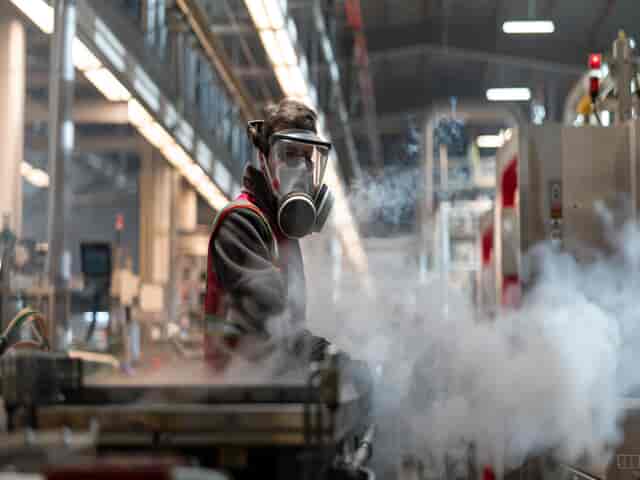Tesla's Fremont plant has been issued more than 100 notices of air quality violations
.2406280904005.png)
Recently, Tesla's Fremont plant has come under scrutiny. It's had many troubling air quality violations. Since 2019, the plant has gotten over 100 notices. They've raised serious concerns about the safety and health of its workers. What exactly are these violations, and how do they impact those who spend their days at the plant? The implications are far-reaching. They affect regulatory compliance and the day-to-day well-being of the workforce.
The Environmental Protection Agency (EPA) has imposed a $275,000 fine on Tesla. How does poor air standard exposure alter the employees daily? From immediate respiratory issues to potential long-term health consequences, the risks are significant. At Pacific Workers, we aim to expose these violations. We've also explored their well-being impacts. We will provide Fremont laborers with practical steps. These steps will help them protect themselves and seek legal help.
Understanding the Violations
Regulatory Framework
Tesla factory has broken several federal air quality laws. The Clean Air Act governs these laws. The CAA established a nationwide system to regulate air grade. It mandates strict standards for emissions of hazardous air pollutants. The EPA enforces these regulations. It checks compliance with regular inspections and reporting. Companies must use pollution control technology. They must also stick to setting emission limits, protecting public health and the environment.
In Tesla's case, the violations show a failure. They failed to follow these federal standards. The EPA enforces rules. They make sure that plants, like Tesla's in Fremont, don't release harmful pollutants. This protects the environment and operatives' health. The rules cover a wide range of pollutants. They include volatile organic compounds (VOCs), particulate matter, and other hazardous substances.
Details of the infractions
Since 2019, the Fremont Tesla plant has gotten over 110 notices of air quality violations. These violations cover many infractions. They range from emitting too much to not keeping proper emission records. The frequency and nature of these acts suggest systemic issues. They're within the plant's environmental management.
The violations include:
VOC emissions exceed the limits. VOCs can cause breathing problems and make ground-level ozone.
Failure to operate and maintain air pollution control equipment as required.
Inadequate record-keeping and reporting of emissions data.
The repeated infringements show big lapses in following the Clean Air Act. They raise concerns about the plant's standards and its commitment to the environment.
Financial penalties
The EPA has imposed a $275,000 fine on Tesla for these violations. The penalty aims to deter. It also shows how serious the infractions are. The fine reflects the total impact of the violations over three years. It shows the need for Tesla to take corrective actions to prevent future breaches.
The financial implications extend beyond the immediate penalty. Not following rules can lead to more scrutiny from regulators. It can cause operational disruptions and harm its reputation. The fine is a reminder for Tesla. It shows the importance of following environmental rules. It also shows the potential costs of not doing so.
Health implications for workers

Short-term haleness effects
Operators at the Fremont plant are at risk of several short-term health effects due to poor air quality. The air has high levels of VOCs and other pollutants. This can cause immediate respiratory issues. They include coughing, wheezing, and shortness of breath. Employees in bad air often get eye irritation and skin rashes.
The immediate salubrity risks are not uncomfortable. They can also lead to less productivity and more absenteeism. High levels of pollutants expose workers and may make it hard for them to do their jobs well. It will affect the plant's operations.
Long-term health consequences
Prolonged exposure to hazardous air pollutants can result in severe long-term well-being consequences. Chronic respiratory conditions, such as asthma and COPD, are common. They impact laborers exposed to poor air quality for long periods. There's also a higher risk of getting lung cancer. There is also a risk of other serious illnesses.
The health impacts can last a long time. They hurt more than the workers do. They also hurt their families and the broader community. Chronic haleness conditions can lead to big medical expenses. They also cause a lower grade of life and an early death. The chance of such bad outcomes shows the high importance of keeping good air class at work.
Worker testimonials
Specific employee testimonials are not included. Yet, it's clear that these violations have a big human impact. Harmful pollutants expose operators. They face daily salubrity challenges. These challenges can hurt their well-being and job performance. The operatives' stories are a powerful reminder. They show the need for strict air standard controls and strong health and safety rules.
Legal Recourse and Worker Rights
Understanding Employees' Compensation
Laborers' compensation laws provide a safety net. They assist employees who are injured or ill from work. In air quality violations, workers get sick from hazardous pollutants. They're entitled to receive compensation. This includes coverage for medical expenses, lost wages, and rehabilitation costs.
Operatives' compensation is a no-fault system. Employees don't need to prove employer negligence to get benefits. This legal framework ensures that workers have access to the help they must. They require it to recover from health issues caused by their work.
Steps to Take if Affected
Bad air hurts operators. They should take these steps to protect their health and rights:
Keep detailed records of exposure incidents. Include the dates, times, and symptoms.
Seek Medical Attention: Visit a healthcare provider. They will document well-being issues and give appropriate treatment.
Report to your employer. Tell them about the haleness issues and exposure incidents.
File a Workers' Compensation Claim. Submit a claim to the right board or agency.
Consult legal services. Seek advice from legal experts. They specialize in employees' compensation and occupational health.
Solutions and preventive measures
Improving air quality standards
To fix the air caliber issues at the Fremont plant, Tesla must take many steps. They've got to follow environmental laws. This includes upgrading pollution controls. It also means improving monitoring and doing regular audits. Audits find and fix potential violations. Tesla can cut harmful pollutants by investing in better emission control systems.
Worker Safety Protocols
Implementing robust safety protocols is essential to protect employees from harmful emissions. This includes providing personal protective equipment (PPE). PPE includes items like respirators and safety goggles. They cut exposure to hazardous substances. Regular training sessions cover air grade management and emergency response. They can also empower operators to take proactive steps to protect their health.
Personal Protective Equipment (PPE): Respirators, safety goggles, and protective clothing.
Regular Training: Air standard management, emergency response procedures.
Health Monitoring: Routine wellbeing check-ups and monitoring for early detection of respiratory issues.
Advocacy and Policy Change
Advocacy is vital. It drives policy change and ensures stricter enforcement of air quality laws. Workers and the public can advocate for stronger regulations and more oversight. They can do this by joining public hearings. They can also do it by talking to policymakers and supporting environmental organizations. Working together can lead to meaningful changes. These changes enhance workplace safety and environmental protection.
By fostering a culture of advocacy and awareness, laborers can help make policies. These policies focus on health and safety. We can do this together. It's going to bring stricter air quality rules and better enforcement, creating a safer work environment for all.
Wrapping Up: The Human Cost of Tesla's Air Quality Violations
Tesla's workforce's health is at stake. The consequences could be long-term and extend beyond the plant. Tesla must install comprehensive measures to improve air standard and ensure worker safety. These violations have big implications. They remind us that it's a legal and moral duty to obey regulations. As we've reflected on these issues, we must ask ourselves: How many more rule-breaking will it take? When will we see real change? Please, contact us if you’re one of the affected Tesla’s operators. We are the lawyers for the injured workers!

.2406280911575.jpg)